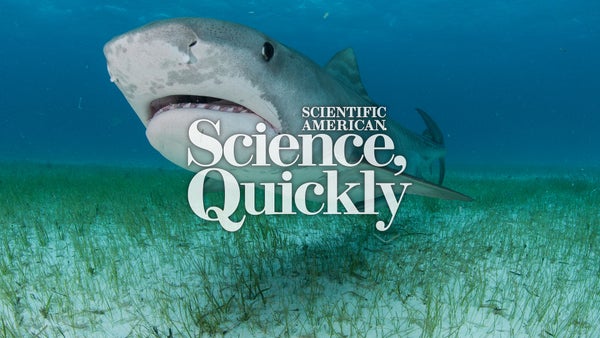An unlikely team of researchers and—get this—tiger sharks has discovered the world’s largest seagrass ecosystem. It’s been hiding in plain sight, just off the coast of the Bahamas. Their results appear in Nature Communications.
Joseph Polidoro: This is Scientific American’s Science, Quickly. I’m Joseph Polidoro.
As ecosystems go, seagrasses are right up there with rain forests and coral reefs.
On supporting science journalism
If you're enjoying this article, consider supporting our award-winning journalism by subscribing. By purchasing a subscription you are helping to ensure the future of impactful stories about the discoveries and ideas shaping our world today.
Austin Gallagher: It's actually one of the most important hubs or magnets for biodiversity.
Polidoro: Austin Gallagher is a marine biologist and CEO of Beneath the Waves, an ocean conservation nonprofit.
Seagrasses are nurseries to a fifth of the world’s largest fisheries and are shelters for thousands of species. They protect other habitats and coastlines. And they store enormous amounts of carbon that would otherwise be released into the atmosphere.
Gallagher: It’s sort of this incredible unsung hero of ocean conservation.
Polidoro: But as much as half the world’s seagrass is yet to be found. We’re protecting these critical ecosystems with surveys that are as accurate as an early Renaissance map of the New World.
That’s because, unlike mangroves and warm-water coral reefs, seagrass meadows aren’t always picked up by satellite or airplane observation. Cloud cover and glare from the seafloor also help keep the Bahamas seagrass hidden.
Carlos Duarte: There’s a lot of false negatives and a lot of false positives.
Polidoro: Carlos Duarte is a marine ecologist at King Abdullah University of Science and Technology in Saudi Arabia.
Duarte: If I had tried to do it myself..., probably I would never have tried.
Polidoro: For decades, Carlos had suspected that the Bahama Banks might host an enormous seagrass habitat. But he couldn’t prove it.
Duarte: Remote sensing will never produce a reliable record. And then ground-truthing the Bahamas Banks, because of the sheer size, proved impossible.
Polidoro: Bu the way — ground-truthing is establishing the on-the-ground truth by direct observation. For seagrass, that’s usually done by divers or by researchers on a boat.
Gallagher: I really believe that if we had not come together like we did, this discovery might not have happened.
Polidoro: Then, by chance, Carlos met Austin–and saw footage from Austin’s shark-mounted cameras.
Gallagher: We saw these vast underwater seagrass meadows.
Polidoro: Carlos had found his ground-truthers.
Gallagher: Tiger sharks were the total game changer of this whole process. Tiger sharks love seagrass habitat. So tiger sharks are this incredible ally.
Polidoro: But how do you collaborate with a large carnivorous shark?
Gallagher: These tiger sharks have teeth that are capable of doing some serious damage. And that’s not demonizing them, that’s just a fact.
Polidoro: For the study, Gallagher’s team caught eight tiger sharks and outfitted them with satellite tags. The researchers also attached cameras to seven more sharks. At first ...
Gallagher: Waves crashing, it’s just hectic, everybody’s shouting. We’re reeling this animal in, trying to restrain it, put rope around its tail, fasten it to the side of the boat.
Polidoro: Once the shark is secured ...
Gallagher: Well it’s actually kind of amazing. It just kind of chills out and is quite peaceful.
Polidoro: In 12 minutes on average for each shark, the team took measurements, collected blood samples and installed the recording equipment. The sharks were then released to roam the Banks’ seagrass meadows.
The tiger sharks were much better observers than humans.
Duarte: They do about 70 kilometers per day, 24/7.
Polidoro: They’re also one fifth the cost of humans or drones.
By combining the shark footage and location data with thousands of boat and diver surveys, the team could correctly interpret satellite images ...
Gallagher: Ultimately revealing the world’s largest seagrass meadow, up to 93,000 square kilometers.
Polidoro: That’s about the size of Portugal and nearly 40 times the size of original estimates. The find increases known seagrasses globally by one third.
The world’s remaining undiscovered seagrass meadows will be smaller, Carlos says. To map them, Carlos will use another charismatic denizen of sea grass ecosystems: sea turtles.
Duarte: We are doing that now in the Red Sea and getting a very reliable mapping. Not only where the seagrass meadows are but in the visual area that they cover.
Polidoro: Carlos and his colleagues will soon be exploring near the Maldives and other archipelagos and island nations in Southeast Asia.
Mapping seagrasses not only helps us protect them; it may also benefit the people who live near them.
Duarte: When you look at the carbon assets in the seagrass meadow and the avoided emissions that can be achieved through conservation and then apportion them to 300,000 people ...
Polidoro: He’s referring to the population of the Bahamas–now over 350,000 people ...
Duarte: Basically every Bahamian owns a million bucks in carbon credits.
Polidoro: The team’s work also puts sharks in a new, more flattering light.
Gallagher: These tiger sharks led us to the seagrass meadows, and we now know that this is going to be a huge benefit for the people of the Bahamas moving forward.
It really demonstrates that if you protect the sharks, which the Bahamas has done, then you could potentially protect the people.
No small accomplishment for 15 tiger sharks and their human colleagues.
Polidoro: For Scientific American’s Science, Quickly, I’m Joseph Polidoro.
Science Quickly is produced by Jeffery DelViscio, Tulika Bose and Kelso Harper. Follow Scientific American for updated and in-depth science news.

